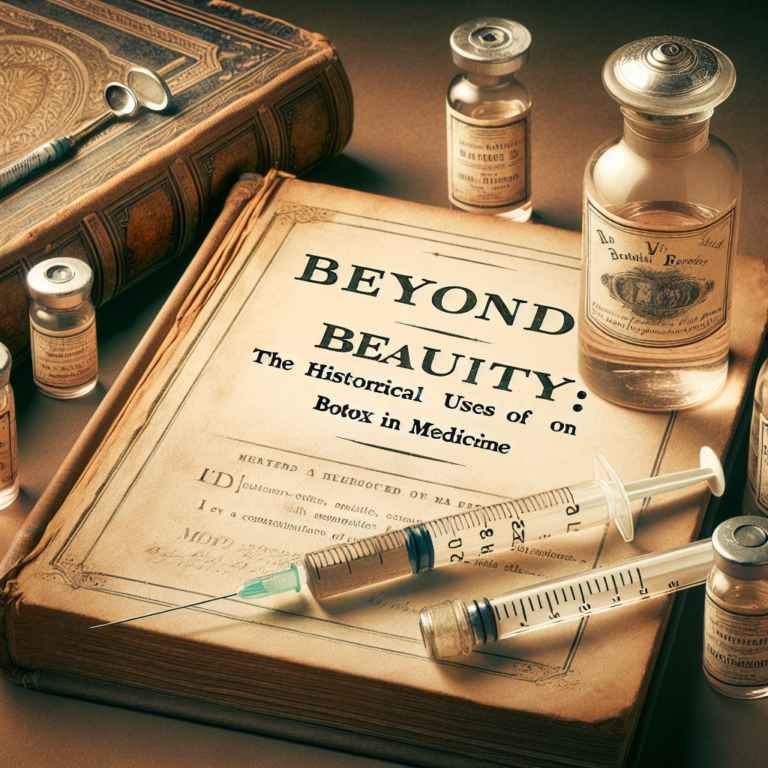Beyond Beauty: The Historical Uses of Botox in Medicine
Botox, often synonymous with aesthetic enhancements and anti-aging treatments, has a rich and varied history that extends far beyond its popular image as a cosmetic miracle worker. Originally derived from the bacterium Clostridium botulinum, Botox has undergone a remarkable transformation from a deadly toxin to a revolutionary medical tool. This article explores the historical uses of Botox in medicine, highlighting its surprising applications and the journey that led to its widespread acceptance.
The Birth of Botox: A Poisonous History
Botulinum toxin, the active ingredient in Botox, was first identified in the late 19th century by German physician Justinus Kerner, who discovered the toxin’s association with spoiled sausages. It wasn’t until the mid-20th century that researchers began to investigate the potential therapeutic uses of botulinum toxin. In the 1970s, scientists started looking at how the toxin could inhibit muscle activity, paving the way for its medical applications.
Medical Pioneers: Early Uses of Botulinum Toxin
The early medical applications of botulinum toxin were primarily targeted at conditions involving excessive muscle contractions. In 1980, Dr. Alan Scott, an ophthalmologist, became the first to use botulinum toxin A to treat strabismus, a condition characterized by misaligned eyes. By temporarily paralyzing the overactive muscles, Scott’s treatments demonstrated remarkable success, leading to FDA approval in 1989 for the use of Botox in the treatment of strabismus.
Expanding Medical Applications
Following its approval for strabismus, researchers began to explore Botox’s potential for treating other medical conditions. In the 1990s, the toxin gained attention for its effectiveness in treating chronic migraines. Patients who previously suffered from debilitating headaches found relief after receiving Botox injections, leading to FDA approval for this use in 2010. This marked a significant milestone for Botox, demonstrating its versatility beyond aesthetic uses.
In addition to migraines, Botox has been employed to treat conditions like cervical dystonia, hyperhidrosis (excessive sweating), and even urinary incontinence. The ability of Botox to inhibit neurotransmitter release and block nerve signals has made it a valuable tool in managing various neuromuscular disorders.
The Aesthetic Revolution
While medical uses were establishing Botox as a legitimate therapeutic agent, its aesthetic applications were fast on the rise. In 2002, Botox received FDA approval for the temporary improvement of frown lines between the eyebrows, effectively launching the toxin into the beauty industry. This approval marked the beginning of a new era where Botox became a household name, synonymous with wrinkle reduction and facial rejuvenation.
The Dual Nature of Botox
The dual nature of Botox—as both a medical treatment and a cosmetic enhancement—highlights the complexities of its perception. While many view it as a quick solution for aging, it serves critical medical functions that can dramatically improve patients’ quality of life. This tension between its aesthetic and medical uses has fueled ongoing discussions about regulation, ethics, and the ever-growing demand for cosmetic procedures.
Safety and Efficacy
As with any medical treatment, the safety and efficacy of Botox have been subjects of extensive research. When administered by trained professionals, Botox is generally considered safe. However, potential side effects, including pain at the injection site, muscle weakness, and allergic reactions, underscore the importance of appropriate training and quality control in its administration.
The Future of Botox in Medicine
Research into the medical applications of Botox continues to evolve. Scientists are exploring its potential benefits in treating conditions such as depression, post-stroke spasticity, and even certain types of pain. As our understanding of the drug’s mechanisms deepens, new applications may emerge, expanding its role in therapeutic settings.
Conclusion
The journey of Botox from a poisonous toxin to a versatile medical agent exemplifies the innovative spirit of medicine. Though it has become a staple in the beauty industry, its roots and ongoing medical applications should not be overlooked. As we continue to explore the potential of Botox, we gain insights into the complexities of treatments that blur the lines between medicine and aesthetics, reminding us that beauty, in its many forms, often lies beyond surface appearances.


